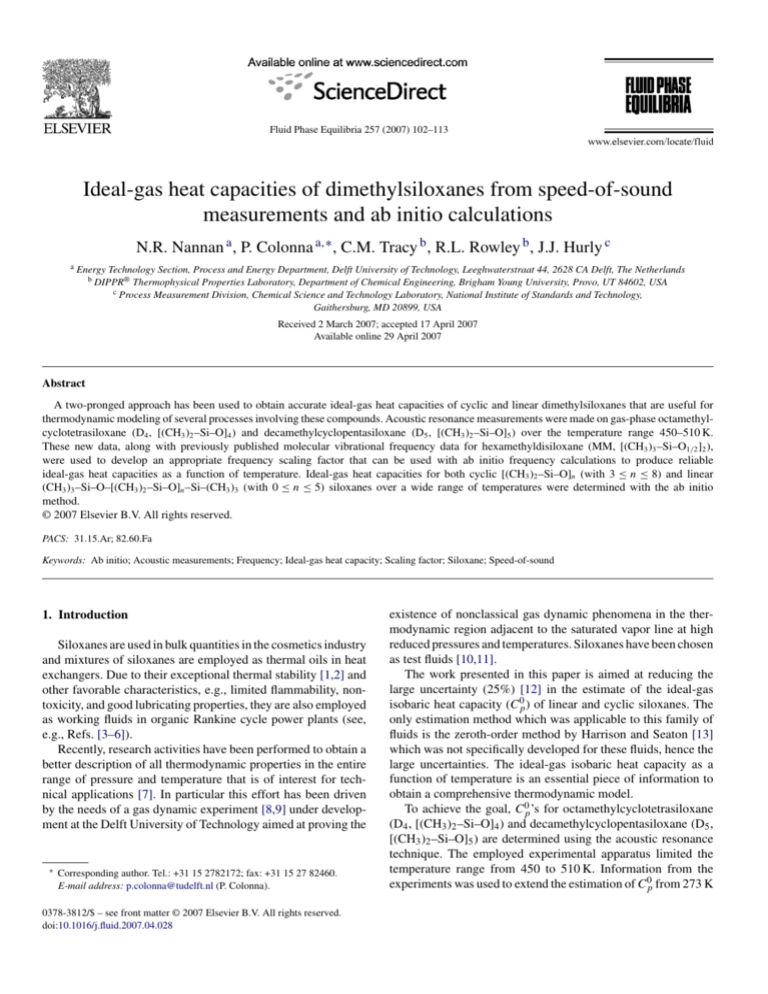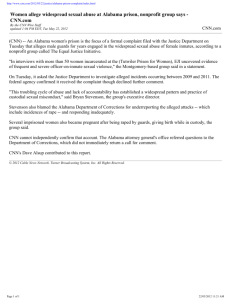
Fluid Phase Equilibria 257 (2007) 102–113
Ideal-gas heat capacities of dimethylsiloxanes from speed-of-sound
measurements and ab initio calculations
N.R. Nannan a , P. Colonna a,∗ , C.M. Tracy b , R.L. Rowley b , J.J. Hurly c
a
Energy Technology Section, Process and Energy Department, Delft University of Technology, Leeghwaterstraat 44, 2628 CA Delft, The Netherlands
b DIPPR® Thermophysical Properties Laboratory, Department of Chemical Engineering, Brigham Young University, Provo, UT 84602, USA
c Process Measurement Division, Chemical Science and Technology Laboratory, National Institute of Standards and Technology,
Gaithersburg, MD 20899, USA
Received 2 March 2007; accepted 17 April 2007
Available online 29 April 2007
Abstract
A two-pronged approach has been used to obtain accurate ideal-gas heat capacities of cyclic and linear dimethylsiloxanes that are useful for
thermodynamic modeling of several processes involving these compounds. Acoustic resonance measurements were made on gas-phase octamethylcyclotetrasiloxane (D4 , [(CH3 )2 –Si–O]4 ) and decamethylcyclopentasiloxane (D5 , [(CH3 )2 –Si–O]5 ) over the temperature range 450–510 K.
These new data, along with previously published molecular vibrational frequency data for hexamethyldisiloxane (MM, [(CH3 )3 –Si–O1/2 ]2 ),
were used to develop an appropriate frequency scaling factor that can be used with ab initio frequency calculations to produce reliable
ideal-gas heat capacities as a function of temperature. Ideal-gas heat capacities for both cyclic [(CH3 )2 –Si–O]n (with 3 ≤ n ≤ 8) and linear
(CH3 )3 –Si–O–[(CH3 )2 –Si–O]n –Si–(CH3 )3 (with 0 ≤ n ≤ 5) siloxanes over a wide range of temperatures were determined with the ab initio
method.
© 2007 Elsevier B.V. All rights reserved.
PACS: 31.15.Ar; 82.60.Fa
Keywords: Ab initio; Acoustic measurements; Frequency; Ideal-gas heat capacity; Scaling factor; Siloxane; Speed-of-sound
1. Introduction
Siloxanes are used in bulk quantities in the cosmetics industry
and mixtures of siloxanes are employed as thermal oils in heat
exchangers. Due to their exceptional thermal stability [1,2] and
other favorable characteristics, e.g., limited flammability, nontoxicity, and good lubricating properties, they are also employed
as working fluids in organic Rankine cycle power plants (see,
e.g., Refs. [3–6]).
Recently, research activities have been performed to obtain a
better description of all thermodynamic properties in the entire
range of pressure and temperature that is of interest for technical applications [7]. In particular this effort has been driven
by the needs of a gas dynamic experiment [8,9] under development at the Delft University of Technology aimed at proving the
∗
Corresponding author. Tel.: +31 15 2782172; fax: +31 15 27 82460.
E-mail address: p.colonna@tudelft.nl (P. Colonna).
0378-3812/$ – see front matter © 2007 Elsevier B.V. All rights reserved.
doi:10.1016/j.fluid.2007.04.028
existence of nonclassical gas dynamic phenomena in the thermodynamic region adjacent to the saturated vapor line at high
reduced pressures and temperatures. Siloxanes have been chosen
as test fluids [10,11].
The work presented in this paper is aimed at reducing the
large uncertainty (25%) [12] in the estimate of the ideal-gas
isobaric heat capacity (Cp0 ) of linear and cyclic siloxanes. The
only estimation method which was applicable to this family of
fluids is the zeroth-order method by Harrison and Seaton [13]
which was not specifically developed for these fluids, hence the
large uncertainties. The ideal-gas isobaric heat capacity as a
function of temperature is an essential piece of information to
obtain a comprehensive thermodynamic model.
To achieve the goal, Cp0 ’s for octamethylcyclotetrasiloxane
(D4 , [(CH3 )2 –Si–O]4 ) and decamethylcyclopentasiloxane (D5 ,
[(CH3 )2 –Si–O]5 ) are determined using the acoustic resonance
technique. The employed experimental apparatus limited the
temperature range from 450 to 510 K. Information from the
experiments was used to extend the estimation of Cp0 from 273 K
N.R. Nannan et al. / Fluid Phase Equilibria 257 (2007) 102–113
103
to the compound’s decomposition temperature by using ab initio calculations and this computational method has also been
employed to provide estimates of Cp0 for the other members of
the linear and cyclic siloxanes family.
Section 2 describes the experimental technique that has
been adopted to measure the speed-of-sound in D4 and D5 .
These experimental data are correlated to obtain an accurate temperature-dependent value of the ideal-gas isobaric heat
capacity. The experimental speed-of-sound data and the derived
data are reported in Section 3. As described in Section 4, information from speed-of-sound measurements can also be used to
fine-tune the frequency scaling factor (FSF) in ab initio calculations. Ab initio calculations were used to obtain the Cp0 as a
function of temperature for six linear (MDn M; n = 0, 1, 2, 3,
4, and 5) and six cyclic members (Dn ; n = 3, 4, 5, 6, 7, and 8)
of the siloxanes family. Section 4 also describes the results of
the geometry optimization and examines the appropriate basisset size for accurate determination of values. Section 5 gives a
summary of the work presented herein.
represents the speed-of-sound in dilute gases as a function of
temperature and pressure. In Eq. (3), βa (T ), γa (T ), and δa (T )
are the second, third, and fourth acoustic virial coefficients,
respectively. These only depend upon the temperature as do the
corresponding virial coefficients B(T ), C(T ), and D(T ) in Eq.
(2). The second acoustic virial and the second density virial are
connected by the thermodynamic relation:
2. Experimental section
Cp0 =
dB(T ) (γ 0 − 1) 2 d2 B(T )
+
T
dT
γ0
dT 2
(4)
More complex expressions relating the higher-order acoustic
virials to the higher-order density virials are also available
[15,16].
Values for the acoustic virial coefficients and the ideal-gas
speed of sound are obtained by fitting Eq. (3) to experimental
speed-of-sound and pressure data along isotherms. From the
fitted values of u0 (T ), the ideal-gas isobaric heat capacity can
be determined from
2
Ideal-gas isobaric heat capacities can be determined by
high-accuracy acoustic resonance techniques. These techniques
measure the frequencies of resonance – and therefore the thermodynamic speed of sound – of sound in a gas sample contained
within a cylindrical or spherical cavity. In the ideal gas limit, i.e.,
when p → 0, where p is the pressure, the thermodynamic speedof-sound u0 is related to the isobaric heat capacity Cp0 according
to
0
C
R̄T
R̄T
2
p
(u0 ) = γ 0
=
(1)
M
Cp0 − R̄ M
Here, γ 0 is the ratio of the isobaric to the isochoric heat capacity
in the ideal-gas state, i.e., γ 0 ≡ Cp0 /Cv0 , R̄ is the universal gas
constant (R̄ = 8314.471 ± 0.014 J/kmol K and was determined
by Moldover et al. [14] using a spherical acoustic resonator), T
is the temperature, and M is the molar mass of the substance.
Therefore, provided that accurate data are available for the molar
mass and for u0 at a specific temperature, the ideal-gas isobaric
heat capacity can be computed from Eq. (1).
For dilute gases, the speed-of-sound smoothly departs from
its ideal-gas value. Analogous to the density virial equation of
state:
p
(2)
= 1 + B(T )ρ + C(T )ρ2 + D(T )ρ3 + · · ·
ρR̄T
which represents the departure of the molar density, ρ, from
ideal-gas behavior for low to moderate density gases, the acoustic virial equation of state,
βa (T )
γa (T )
u(T, p) = u0 1 +
p+
p2
R̄T
R̄T
δa (T )
]+
p3 + · · ·
R̄T
2
βa (T ) = 2B(T ) + 2(γ 0 − 1)T
(3)
(u0 ) M
2
T [(u0 ) M/R̄T − 1]
(5)
A detailed description of the experimental equipment is given by
Gillis [16]. In the following subsections only a brief description
of the resonator and of the measurement procedure is given.
2.1. The resonator
The resonator that was used for resonance frequency measurements was a cylinder with circular cross-section and was
fabricated of a copper–nickel alloy. The height was approximately 14 cm and the width was about 6.5 cm (see Fig. 1).
The internal surface of the resonator was polished to a mirror
finish, therefore, the flat surface area was accurately known.
To achieve good temperature stability and fast temperature
equilibration, the cylinder was completely submerged in a
continuously stirred liquid bath. This thermostated bath guaranteed that the temperature fluctuations in the gas sample were
within 1 mK. The top plate of the cylinder contained a carefully designed port for charging and removal of the sample. The
electro-acoustic transducers, these are the sound source and the
microphone detector, were remote from the resonator because
the high temperature of the thermostated bath was not compatible with these transducers. Instead, the sound waves generated
at (received by) the source (microphone detector), were carried
to (from) the resonator by waveguides. The waveguides are hollow cylindrical tubes with horn-shaped cross-sections and were
filled with argon. Apart from protecting the electro-acoustic
transducers from the harsh environment of the thermostated
bath and the gas in the resonator, the physical separation of
the transducers by the waveguides reduces electro-magnetic
and mechanical disturbances between the sound source and
the microphone detector. A metal membrane separated the
argon in the waveguides from the siloxane sample. In order
to damp resonances in the waveguides, which might complicate the resonance-frequency measurements in the sample, a
104
N.R. Nannan et al. / Fluid Phase Equilibria 257 (2007) 102–113
capacity is approximately:
⎤
⎡
⎥
⎢ 0
0 )
⎥
⎢ Cp,i
σ(Cp,t
Mi
1
⎥ x + O(x2 )
⎢
≈
−
1
+
−
1
⎥
⎢
0
0
0
M
Cp,t
C
(γ
−
1)
t
⎣
p,t
t
⎦
first term
Fig. 1. Schematic representation of the cylindrical resonator, the waveguides,
and the electro-acoustic transducers (adapted from Ref. [15]). E: sound emitter, D: sound detector, R: resonator, and PRT: standard platinum resistance
thermometer.
second term
(6)
Subscripts t and i denote the fluid sample and the impurity,
respectively, and x denotes the mole fraction of impurity in the
sample. Usually the term involving the ratio of the isobaric heat
capacity of the impurity and that of the sample is small compared to the second term in Eq. (6). Complex fluids with many
active vibrational degrees of freedom at the temperature of interest have large heat capacities and heat capacity ratios, γt0 , very
close to unity. For example, γt0 ≈ 1.017 for D4 at 500 K if Cp0 is
estimated using the Harrison–Seaton method. This means that
if the D4 sample contains impurities for which (Mi /Mt − 1) is
0 is of the
of the order of unity, the fractional uncertainty in Cp,t
order of 50 times the mole fraction of the impurity.
The test fluids were octamethylcyclotetrasiloxane (D4 ,
[(CH3 )2 –Si–O]4 ) and decamethylcyclopentasiloxane (D5 ,
[(CH3 )2 –Si–O]5 ) and had been supplied by the European
branch of the Tokyo Chemical Industry Co., Ltd.2 These
fluids were rated by the manufacturer as 99.9+% pure, no
gas-chromatographic analysis was done. The impurities that
were present were most likely other siloxanes. Before the fluids
were loaded into the resonator, they were thoroughly degassed
to remove air and other volatilities by repeatedly freezing the
fluid in liquid nitrogen and evacuating the space above the
frozen sample.
metal screen was placed in both waveguides near the metallic
membrane.
The pressure of the sample was measured with a
quartz-bourdon-tube pressure gauge in conjunction with a
diaphragm-type differential pressure transducer (DPT). The
pressure gauge measured the pressure of argon in the waveguides and the DPT, which was always kept at 230 ◦ C, measured
the pressure difference between the argon and the sample. To
avoid pre-condensation,1 the pressure of the test fluid was kept
to 80% of the vapor pressure of the sample at the bath temperature or to that corresponding to 230 ◦ C, which ever was lower. At
the highest temperature that was reached, the DPT was relatively
colder, so that was the limiting temperature.
2.3. Calibration
2.2. Sample purity
L = L0 [1 + α(T − T0 )]
A major source of uncertainty in Cp0 derived from speedof-sound data is sample impurity. For small levels of impurity,
the fractional uncertainty in the derived ideal-gas isobaric heat
Here, L0 denotes the length of the cylinder at the reference
temperature T0 = 273.15 K. From measurements with argon,
it was inferred that L0 equals 14.04 cm. The thermal expansion
1 Pre-condensation is a phenomenon whereby, if the thermodynamic state of
the test fluid is close to saturation, evaporation and condensation occur at the
resonator walls as a consequence of pressure and temperature variations caused
by the acoustic cycle.
2 Certain trade names and products are identified only to adequately document the experimental equipment and procedures. This does not constitute an
endorsement by the National Institute of Standards and Technology, nor does it
imply that the products are necessarily the best available for the purpose.
For accurate speed-of-sound measurements, the resonator
needs to be calibrated. Calibration of the resonator is necessary
in order to determine the temperature-dependent dimensions of
the cylinder. This was achieved by measuring the frequencies of
resonance of different acoustic modes in argon in the temperature and pressure range of interest. Argon was chosen for the
calibration, because it is inert and because its transport properties
and speed-of-sound are known with high accuracy.
For the cylinder that was used to measure the sound speed
in the siloxanes, the following dimensions were obtained for
temperatures between 350 and 500 K:
(7)
N.R. Nannan et al. / Fluid Phase Equilibria 257 (2007) 102–113
coefficient of the copper–nickel alloy was fitted by
α = AT B
(8)
with the result A = 1.184 × 104 K−B−1 and B = 1.866 ([α] =
K−1 ). The radius had the following temperature dependence:
R = R0 [1 + α(T − T0 )]
(9)
The radius R0 at T0 = 273.15 K was determined from the calibration run with argon. From the obtained data it was inferred
that R0 equals 3.279 cm. All pressure and temperature transducers were calibrated only once.
2.4. Measurement procedure
105
layers, (ii) sound absorption in the bulk of the fluid as a consequence of the local rate of compression and fluid friction,
(iii) irreversible heat flows in the bulk of the fluid due to the
periodic changes in temperature during the acoustic cycle,
and (iv) imperfections in the cylinder such as the fill duct and
the gap at the O-ring seal.
• After the measurement sequence for each thermodynamic
state, the pressure was reduced by about 10 kPa while the
temperature was kept constant. Once pressure and temperature equilibrated (this required about 5 min), the resonance
frequencies were measured again. The detected response of
the measured resonance frequency is pressure dependent and
attenuates with decreasing pressure. Consequently, the lowest
pressure at which resonance frequencies were measured was
22 kPa.
The measurement procedure was as follows:
• At first, the thermostated bath was set to the desired measurement temperature. Once this temperature was reached, the
resonator was charged with the gas sample. Acoustic measurements were made at pressures up to 80% of the vapor-pressure
at the thermostated temperature. At pressures closer to the
dew point, condensation at the walls due to the acoustic cycle
can become a problem. This so-called pre-condensation lowers the apparent speed of sound [17]. The vapor-pressure was
determined from the AIChE DIPPR® Equation [12], using the
substance specific parameters for the siloxanes D4 and D5 ,
given by Flaningam [18].
• After the temperature of the gas sample had equilibrated,
selected purely longitudinal modes and one purely radial
mode were measured. Redundant measurements were conducted to give confidence that the correct modes were
measured. Because of the low speed of sound it is important
for the siloxanes considered herein to distinguish between
pure and mixed modes. For example, the first purely longitudinal mode for D4 at 450 K occurs at a frequency of about
380 Hz. Because the experimental equipment (resonator and
transducers) is not specifically designed (selected) to measure frequencies significantly below 1 kHz, it was necessary
to measure higher modes (at low frequencies the signal-tonoise ratio is small). However, higher modes are spaced closer
to each other than, for example the first and second purely
longitudinal modes. It is therefore important to do redundant
measurements in order to check (but also to distinguish) which
modes are measured and whether they are pure modes or
mixed modes. Additionally, redundant modes give a measure
of the uncertainty in the resonance frequency f. To account
for first-order drifts that can occur in temperature and pressure during a measurement cycle, each resonance frequency is
measured three times. Furthermore, at each measurement, the
so-called interval sweep of the scan is in two directions, i.e.,
from f − g to f + g and then back from f + g to f − g. Here,
g is the experimentally determined half-width, i.e., the width
of the resonance frequency at 2−1/2 -times the signal’s maximum amplitude. Known contributions to the half-width (loss
mechanisms) are: (i) sound absorption at the metal-gas boundaries due to the formation of thermal and viscous boundary
3. Experimental results
3.1. Experimental data for D4
The speed of sound in D4 was measured along the isotherms
of 450, 465, 480, and 495 K. The lower temperature limit was
chosen based on the fact that, for good speed-of-sound measurements in this apparatus, the pressure of the sample should
be at least greater than 30 kPa and less than 80% of the vaporpressure at the temperature of measurement. At lower pressures
the signal-to-noise ratio is small and therefore it is difficult
to measure the resonance frequency. The upper temperature
limit is determined by the maximum allowed temperature of
the liquid used in the thermostated bath and the highest temperature at which the DPT can operate. The pressure spanned the
range 27–225 kPa. The measured modes included the 5th and
7th purely longitudinal mode and the 1st purely radial mode.
The experimental resonance frequency f exp is slightly lower
than the ideal resonance frequency f from which the true speed
of sound should be determined. The shift in frequency, i.e.,
f , is the result of the viscous and thermal boundary layers
at the walls of the resonator. The shift in frequency depends
upon the transport properties of the fluid sample, namely the
shear viscosity, the bulk viscosity, and the thermal conductivity. Trusler [19] gives relevant equations that should be used
to compute the frequency shift f ; moreover, f is related
in part to the experimentally measured half-width of the signal
(note that irreversibilities in the bulk of the sample contribute
to the experimental half-width of a resonance frequency but are
not responsible for the frequency shift). Because of the large
uncertainty in transport-property estimates for siloxanes [12],
this study uses the following simple correlation to determine the
ideal resonance frequency:
f = f exp + gexp
(10)
where gexp denotes the half-width obtained from the measurements.
The speed-of-sound data obtained from these frequencies/modes was fit to the acoustic virial equation of state Eq. (3)
to obtain the second and third acoustic virial coefficient at every
106
N.R. Nannan et al. / Fluid Phase Equilibria 257 (2007) 102–113
temperature. Using the relationship between the second acoustic
virial and the second density virial, as expressed by Eq. (4), values were also obtained for B at the four temperatures [20]. From
the speed-of-sound data, ideal-gas isobaric heat capacities have
been derived. Because of the relatively small temperature range
of measurement, it was assumed that Cp0 has a linear dependence
on temperature, i.e.:
Cp0
R̄
= a1 + a2 T
(11)
where a1 and a2 are substance-dependent parameters.
Table 1 lists the experimental speed-of-sound data together
with the uncertainties in u and Table 2 gives the derived u0 ’s
and ideal-gas isobaric heat capacities at each temperature of
measurement.
The experimental Cp0 data, which, on average, have a predicted experimental uncertainty of 3.9%, are compared with
the estimates determined from the Harrison–Seaton method.
It is observed that the experimental Cp0 ’s are within the
uncertainty assigned by DIPPR® [12]. Moreover, within the
experimental temperature range, i.e., 450 K < T < 495 K, the
Harrison–Seaton method gives values for Cp0 that are lower than
the experimentally derived data by approximately 4%.
3.2. Experimental data for D5
The speed of sound in D5 was measured along the isotherms
of 485, 500, and 510 K. The pressure spanned the range
22–117 kPa. The measured modes were again the 5th and 7th
purely longitudinal mode and the 1st purely radial mode. These
experimental frequencies were corrected using Eq. (10). The
speed-of-sound data and the experimental uncertainties are given
in Table 3 and the derived u0 ’s and ideal-gas isobaric heat
capacities are presented in Table 4. A comparison of the experimentally determined ideal-gas isobaric heat capacities (these
have an average experimental uncertainty of 5.5%) with estimates obtained from the Harrison–Seaton method shows that
although the experimental Cp0 ’s are within the uncertainty of
the group-contribution method [12], the experimental Cp0 ’s are
lower than values determined from the Harrison–Seaton method
and values obtained from our ab initio predicted values (see
Section 5). This is contrary to what was observed for D4 .
We believe that this discrepancy is a consequence of impurities in the D5 sample: since the same resonator was used for
resonance frequency measurements in both fluids, it is reasonable to assume that minute amounts of D4 were present during
the measurements in D5 . This reasoning is consistent, since a
lighter constituent in the sample of D5 means that the speed
of sound is greater with respect to a measurement not affected
by impurities. Moreover, using Eq. (6) it is found that 0.07%
of D4 as an impurity in D5 , reduces the ideal-gas isobaric heat
capacity by as much as 1%. This level of impurity could have
been measured using gas-chromatography (GC). However, no
GC analyzer with the required sensitivity was available in the
laboratory, therefore it was impossible to check whether crosscontamination due to incomplete clean-out of the resonator had
Table 1
Experimental speed-of-sound data for D4 at certain values for pressure and
temperature (the experimental uncertainties are also listed)
T (K)
σ (×104 m/s)
p (kPa)
u (m/s)
450
38.90
46.70
57.41
62.89
69.33
110.351
109.656
108.801
108.299
107.727
252.0
89.8
72.2
17.0
16.4
465
31.29
40.99
49.18
58.99
70.69
77.48
92.89
101.01
111.40
121.67
113.043
112.320
111.723
110.976
110.062
109.530
108.286
107.535
106.695
105.761
638.9
123.0
69.2
20.2
16.5
24.9
9.9
14.3
5.3
7.4
465
36.51
47.85
57.21
68.51
74.87
81.72
97.68
106.95
116.93
112.753
111.913
111.202
110.332
109.829
109.278
107.963
107.179
106.300
138.6
37.2
25.3
14.4
10.7
26.5
270.8
89.7
335.1
465
32.63
46.84
61.46
73.59
87.87
105.11
123.48
112.986
111.935
110.824
109.872
108.720
107.277
105.664
242.5
53.3
18.8
15.3
9.0
15.0
17.4
480
42.70
54.67
65.08
71.30
85.50
92.46
109.21
118.88
129.21
140.39
152.36
165.42
114.022
113.202
112.478
112.038
111.071
110.502
109.241
108.493
107.675
106.769
105.769
104.642
56.2
18.1
36.1
24.6
24.9
12.1
4.5
3.1
6.8
11.2
8.6
6.3
495
27.45
36.20
47.54
143.41
159.70
160.40
174.53
186.64
198.61
224.52
117.135
116.658
115.985
109.744
108.434
108.391
107.346
106.439
105.492
103.408
200.8
71.6
15.6
283.3
20.5
105.0
44.6
78.7
1287.4
31.8
occurred. Even more importantly, only after the results from
the ab initio computations became available, did it become a
point of concern that contamination of the D5 sample might have
happened.
N.R. Nannan et al. / Fluid Phase Equilibria 257 (2007) 102–113
Table 2
Derived values for the ideal-gas speed of sound and isobaric heat capacity of D4
107
Table 4
Derived values for the ideal-gas speed of sound and isobaric heat capacity of D5
T (K)
u0 (m/s)
σ(u0 )/u0 (%)
Cp0 (J/mol K)
σ(Cp0 )/Cp0 (%)
T (K)
u0 (m/s)
σ(u0 )/u0 (%)
Cp0 (J/mol K)
σ(Cp0 )/Cp0 (%)
450
465
480
495
113.320
115.169
116.988
118.780
0.014
0.041
0.019
0.060
469.466
480.646
491.826
503.005
1.55
4.66
2.21
7.14
485
500
510
105.067
106.664
107.715
0.025
0.042
0.054
563.285
574.465
581.918
3.34
5.72
7.45
Remark that, since the ideal-gas heat capacity ratio is close to
unity, the presence of impurities can greatly influence the uncertainty in derived ideal-gas isobaric heat capacities. Furthermore,
due to the low volatility of the siloxanes, the experiment had to
be conducted at high temperatures. A viable approach to obtain
accurate Cp0 ’s is the use of a buffer gas, e.g., argon, for which
Table 3
Experimental speed-of-sound data for D5 at certain values for pressure and
temperature (the experimental uncertainties are also listed)
p (kPa)
u (m/s)
σ (×104 m/s)
82.92
64.42
49.43
97.275
99.132
100.666
62.3
101.4
75.2
485
85.12
74.85
63.60
55.24
43.63
35.39
97.170
98.380
99.197
100.360
101.141
101.908
56.7
97.0
119.9
44.5
450.6
238.9
500
116.60
105.42
95.37
85.90
74.95
64.64
55.42
42.70
33.93
26.30
96.555
97.603
98.558
99.495
100.631
101.500
102.199
103.271
103.964
104.683
219.5
59.0
54.0
65.5
17.9
31.9
161.5
134.2
215.7
16.3
500
78.98
47.88
31.33
22.48
100.217
102.870
104.222
104.919
28.6
32.7
75.4
126.8
500
73.64
64.96
51.58
39.90
32.27
22.13
100.810
101.440
102.577
103.532
104.140
104.938
63.4
122.6
0.6
26.2
11.9
0.0
510
110.69
89.89
57.10
34.55
99.980
100.871
103.487
105.200
120.1
49.5
52.7
31.7
510
103.28
92.75
82.51
72.53
62.78
51.27
43.26
99.891
100.754
101.583
102.369
103.980
104.860
104.679
82.5
5.9
20.3
5.4
261.9
55.7
19.2
T (K)
485
accurate thermophysical properties are available. By measuring
the shift in resonance frequency due to the addition of a small,
but accurately known amount of siloxane in the buffer gas, one
can obtain the value of the ideal-gas heat capacity ratio of the
argon–siloxane mixture, from which Cp0 of the siloxane can be
determined. This approach has been used by Colgate et al. [21]
for measuring Cp0 ’s of n-butane, isobutane, and n-heptane. This
technique will be considered for possible developments of this
work, but it could not be adopted at the time of the measurements herewith documented because the available cylindrical
resonator was not suitable and several modifications should have
been implemented.
4. Ab initio calculations
Several different families of siloxanes have been successfully
studied with ab initio methods to help elucidate the relatively
flexible Si–O backbone structure that is largely responsible for
many of their useful properties [22]. Previous studies show that
the Si–O bond is relatively short. This has been attributed to
the high ionic character of the bond [23] and to partial transfer of electronic charge from the O lone electron pair to the Si
atom [22]. The bending force constant for the Si–O–Si bond
angle is very small, and the angle varies between 140◦ and 180◦
[22,24,25] for different molecules. For example, using HF calculations with modest basis sets for cyclo-n-trisilicic acids, Hill and
Sauer [24] found Si–O–Si angles of 163.6◦ , 178.6◦ , and 166.4◦
for the n = 4, 5, and 6 rings, respectively. Freire et al. [22] found
considerable differences in the stable geometries of dimethyl
and diphenyl siloxane chains. The torsional barriers for rotations
about the Si–O bonds are also quite low [22]. Thermodynamic
measurements have shown that internal rotation about the Si–O
bond in hexamethyldisiloxane (MM, (CH3 )3 –Si–O1/2 ]2 ) is free,
or nearly so [26]. Other experimental results, such as X-ray and
electron diffraction [27], also agree quite well with the bond
lengths and angles obtained from ab initio calculations.
The use of higher levels of theory and larger basis sets has
been limited by the molecular size of these molecules and the
number of electrons involved. However, Kudo et al. [27] used
6-31G* and 6-311G(d,p) basis sets with both HF and MP2 calculations for specific conformations of (H2 SiO)n with n = 3, 4,
5. In most cases, the optimized geometries and energies were
similar for the HF and MP2 calculations, though the MP2 inclusion of electron correlation effects changed the stability order of
some conformations of nearly equal energies.
We are not aware of any previous Cp0 determinations from
ab initio frequency calculations on the dimethylsiloxane family.
In this study we have applied HF calculations with basis sets
similar to those used by Kudo et al. on the dihydride siloxanes.
108
N.R. Nannan et al. / Fluid Phase Equilibria 257 (2007) 102–113
We initially determine the convergence of calculated Cp0 values
with basis set size for MM. This basis set is then used for the
geometry optimization and frequency calculations on all 12 of
the molecules studied here.
4.1. Basis-set dependence
The ideal-gas heat capacity is related to harmonic characteristic vibrational temperatures, Θj , within the molecule by
[28]:
3m−6
Θj 2
Cp0
exp(Θj /T )
(12)
=4+
R̄
T
[exp(Θj /T ) − 1]2
j=1
where m is the number of atoms in the molecule and Θj is related
to the intramolecular vibrational frequencies, νj , by
Θj =
hνj
k
(13)
Here h and k are Planck’s and Boltzmann’s constants, respectively. The derivation of Eq. (12) also assumes independence of
the rotational and vibrational modes.
In this work, harmonic frequencies for the optimized geometry were obtained from frequency calculations using Gaussian
98 [29], and these were used in Eq. (12) to obtain Cp0 values. Frequencies determined from ab initio calculations may differ from
those measured experimentally due to the incomplete inclusion
of electron correlation effects and the use of finite basis sets. In
all cases, we used the same basis set for the frequency and optimization calculations, but Cp0 values for MM were generated
using increasingly larger basis sets to determine convergence
of Cp0 with the number of basis functions employed. MM is
the only compound of those studied for which experimental frequency information is available [26]. The basis sets used and the
corresponding number of basis functions are given in Table 5.
While the 3-21G basis set is too small for accurate Cp0 calculations, acceptable convergence is obtained for 6-31G(d) and
larger basis sets. The addition of diffuse functions tends to lower
Cp0 values for the double zeta basis sets, but the use of 6-31G(d)
gives values consistent with the largest basis set studied. We used
HF/6-31G(d) and HF/6-31+G(d) for all subsequent calculations.
Geometry optimizations and frequency calculations were
made using HF/6-31G(d) and HF/6-31+G(d) for six linear
MDn M siloxanes (0 ≤ n ≤ 5) and for six cyclic Dn siloxTable 5
Basis set dependence of Cp0 (J/mol K) values
Basis set
3-21G
6-31G(d)
6-31+G(d)
6-31G(d,f)
6-31+G(d,f)
6-311G(d,f)
6-311+G(d,f)
Number of
basis functions
T (K)
273.15
500
1000
1500
125
179
215
242
278
295
331
189.84
220.15
213.50
221.72
214.43
222.49
222.57
290.93
322.81
315.91
324.65
317.48
326.53
326.77
434.8548
463.2236
455.6175
464.3449
456.7552
466.1793
466.3486
512.5241
539.1128
531.1374
539.7807
531.8967
541.1331
541.2369
anes (3 ≤ n ≤ 8). All optimization calculations were performed
without constraints. Several previous studies have restricted
optimizations to investigate the relative energies of particular
conformations. In the study of dihydride siloxanes, Kudo et al.
[27] found very close energies for the D5h , C5V and C1 conformations with a minimum for the unconstrained C1 conformation.
We have chosen to use the unconstrained C1 optimized configuration, as did Hill and Sauer [24]. Evidence of the optimum
geometry included convergence to the same minimum from different initial configurations and the absence of any imaginary
frequencies. Average Si–O bond lengths and Si–O–Si angles,
with the corresponding ranges of values observed within the
molecule, are shown in Table 6. The O–Si–O bond angle is essentially tetrahedral and is not included in the table. Other bond
lengths and angles are available from the authors upon request.
Illustrative figures of the optimized geometries are shown for D3 ,
D4 , D5 , and MD5 M in Fig. 2. Our results for D3 , D4 and D5 are
very similar to the C1 geometries reported by Kudo et al. [27] for
the corresponding dihydride cyclic compounds. D3 is planar, D4
is very nearly planar, and D5 , D6 and D7 are puckered so that their
geometries resemble the chair conformations of the corresponding cycloalkanes containing 5, 6 and 7 carbons, respectively. The
geometry of D8 is more like a boat structure with the bow and
stern bent toward each other. Again the Si–O–Si angle is seen to
be relatively flexible and adjusts easily to steric constraints of the
ring structure. The Si–O–Si bond angle is 134.1◦ in D3 , 157.9◦
in D4 , and 158.9◦ in D5 . For the linear molecules, the Si–O–Si
bond angle decreases from 180◦ for MM to 160◦ for the longer
molecules. Interestingly, the larger linear MDn M siloxanes tend
to form a corkscrew shape as illustrated in Fig. 2 for MD5 M.
4.2. Frequency scaling factor
Currently, determination of high accuracy Cp0 values from
ab initio calculations requires use of an empirically determined
frequency scaling factor (FSF) that adjusts harmonic frequencies for use in Eq. (12) closer to the actual values. In so doing,
it is assumed that the scaling factors compensate for anharmonic effects, errors resulting from the electronic structure
calculations, and any lack of complete independence between
vibrational and rotational modes. It has been found that such
scaling factors are relatively uniform for specific combinations
of theory and basis set, and considerable effort in obtaining FSF
values is evident in the literature. Early on, Pople et al. [30] proposed a FSF of 0.89 for HF/3-21G, Hout et al. [31] suggested
a FSF of 0.921 for MP2/6-31G(d), and DeFrees and McLean
[32] recommended values of 0.96 for first-row molecules and
0.94 for second-row molecules. More recently, Scott and Radom
[33] developed and tabulated FSF’s for a large number of model
chemistries. They recommend FSF = 0.8953 for HF/6-31G(d)
and FSF = 0.8970 for HF/6-31+G(d). More recently Irikura et
al. [34] reported an analysis of scaling factors based on 358
molecules using the computational chemistry comparison and
benchmark database (CCCBDB) maintained by the National
Institute of Standards and Technology. These authors also performed careful statistical analysis of the resultant frequency factors and determined uncertainties of their recommended values.
N.R. Nannan et al. / Fluid Phase Equilibria 257 (2007) 102–113
109
Table 6
Backbone Si–O bond lengths and Si–O–Si angles in the optimized geometries showing the average values and the minimum and maximum values within the molecule
Siloxane
Si–O–Si angle (◦ )
Si–O bond (Å)
Average
Minimum
Maximum
Average
Minimum
Maximum
Linear
MM
MDM
MD2 M
MD3 M
MD4 M
MD5 M
1.635
1.631
1.630
1.633
1.633
1.633
–
1.625
1.625
1.627
1.626
1.627
–
1.637
1.639
1.645
1.643
1.644
180.00
178.35
168.65
161.16
160.06
159.57
–
178.35
168.47
154.08
158.76
154.81
–
178.35
169.01
168.96
160.77
164.89
Cyclic
D3
D4
D5
D6
D7
D8
1.648
1.633
1.632
1.632
1.631
1.632
–
–
1.630
1.632
1.629
1.627
–
–
1.635
1.633
1.634
1.635
134.05
157.86
158.90
157.55
159.48
157.94
–
–
153.95
154.97
154.65
152.93
–
–
167.35
160.51
163.28
163.60
Fig. 2. Optimized structures of some of the considered siloxanes. (a) D3 , (b) D4 , (c) D5 , (d) MD5 M.
110
N.R. Nannan et al. / Fluid Phase Equilibria 257 (2007) 102–113
Table 7
Recommended FSF values for siloxanes
Compound
HF/6-31G(d)
HF/6-31+G(d)
MP2/6-31+G(d)
MM
D4
Average
1.0316
1.0324
1.0320
0.9898
1.0077
0.9988
1.0381
–
–
Because tabulated FSF values have been based on organic
molecules containing primarily first and second-row elements,
it is unclear how effective these values are in correlation and
prediction of siloxane thermochemical properties. We have
therefore regressed from our experimental Cp0 values for D4 and
from available thermochemical data for MM [26] FSF values
for siloxanes appropriate for the basis sets used in this work.
The resulting values, shown in Table 7, are consistent between
the two compounds but closer to unity than the corresponding
FSF values employed for non-Si compounds. The average values shown in Table 7 are used throughout this work to predict
Cp0 values for all of the remaining siloxanes. As an indication
of possible electron correlation effects on the FSF, we also performed MP2/6-31+G(d) calculations on MM. The resultant Cp0 ’s
were in excellent agreement with experimental values with an
optimized FSF = 1.0381.
As mentioned, the FSF scaling of the frequencies attempts
to compensate for deviations from the theoretical model. In
our case this includes deviations not only due to anharmonicity
effects and mode coupling effects, but also deviations in Cp0 due
to our modeling the fluid with the optimized geometry. The real
fluid will be an equilibrium mixture of molecular conformers,
but calculations of Cp0 for a couple of different conformations
indicates that the variation in Cp0 values amongst conformers is
likely very small and adequately accounted for by using the FSF.
4.3. Predicted ideal-gas heat capacities
Frequencies were obtained for the six linear and six cyclic
dimethyl siloxanes, adjusted using the average FSF shown in
Table 7, and used with Eqs. (12) and (13) to obtain the values
given in Table 8 at various temperatures. The values shown are
predicted and of course only apply to the real-gas phase up to
temperatures at which they decompose. Several low frequency
modes associated with Si–O–Si angle bending were consistent
with the known flexibility of this angle. Similar calculations
were made using HF/6-31+G(d) for three MDn M and three Dn
compounds, and these results are shown in Table 9. Results
are similar for the two basis sets though the predicted values
are often slightly higher with the use of diffuse functions on
Table 8
Cp0 (J/mol K) values predicted for linear and cyclic siloxanes using HF/6-31G(d) (values given for temperatures above the decomposition temperatures are hypothetical)
Siloxane
T (K)
298
300
400
Linear
MM
MDM
MD2 M
MD3 M
MD4 M
MD5 M
232
330
403
524
621
718
234
331
405
526
624
721
281
397
489
629
745
861
Cyclic
D3
D4
D5
D6
273
364
469
566
274
365
471
568
D7
D8
663
759
666
762
500
600
700
800
900
1000
1200
1400
323
455
562
719
851
983
359
505
625
795
941
1086
390
547
679
881
1018
1174
418
584
726
918
1084
1251
442
617
767
968
1143
1318
463
646
804
1012
1194
1377
499
694
865
1085
1280
1476
527
732
913
1143
1348
1553
331
439
564
680
379
503
643
775
420
557
710
856
454
602
768
925
484
641
817
984
509
676
860
1035
532
706
897
1080
570
756
960
1155
599
795
1009
1214
796
911
907
1039
1001
1146
1081
1238
1150
1317
1210
1385
1263
1446
1351
1546
1419
1624
Table 9
Cp0 (J/mol K) values predicted for selected linear and cyclic siloxanes using HF/6-31+G(d) (values given for temperatures above the individual decomposition
temperatures are hypothetical)
Siloxane
Linear
MM
MDM
MD3 M
Cyclic
D3
D4
D5
T (K)
298
300
400
500
600
700
800
900
1000
1200
1400
231
338
537
232
339
539
280
406
644
322
465
734
358
515
811
390
557
876
417
594
933
441
627
983
462
656
1026
498
704
1099
525
741
1155
279
364
472
280
366
474
338
441
568
387
506
648
428
559
716
462
605
773
491
644
822
517
678
864
539
708
902
576
758
963
605
796
1011
N.R. Nannan et al. / Fluid Phase Equilibria 257 (2007) 102–113
111
Fig. 3. Experimental Cp0 values for D4 (䊉) compared to ab intio values predicted
by HF/6-31G(d) (solid line) and HF/6-31+G(d) (dashed line) calculations using
the recommended FSF.
Fig. 4. Comparison of experimental Cp0 values for D4 (䊉) with those predicted
with the Harrison–Seaton group contribution method (), with Eq. (14) (),
and with HF/6-31G(d) (solid line).
the heavier nuclei. Fig. 3 compares the D4 experimental values
measured here to the ab initio values predicted using the recommended average FSF value developed in the previous section.
Fig. 4 compares our experimental results for D4 with values
predicted by other means. Values predicted using the simple
Harrison–Seaton group-contribution method are in very good
agreement with the ab initio predicted values over the whole
temperature range. Also shown in this figure are values of Cp0
estimated using the approximate relationship:
dHvp
Cp0 ≈ Cp,L +
(14)
dT
sat
Fig. 5. Comparison of Cp0 values predicted with HF/6-31G(d) (solid line) calculations to those predicted using the Harrison–Seaton method (), Eq. (14) (),
experimental vibrational frequencies (), and experimental measurements (䊉) for (a) MM, (b) MD3 M, (c) MD5 M, and (d) D5 .
112
N.R. Nannan et al. / Fluid Phase Equilibria 257 (2007) 102–113
with values for the enthalpy of vaporization, Hvp , and the saturated liquid heat capacity, Cp,L , obtained from the recommended
temperature correlations in the DIPPR® database [12]. Eq. (14)
neglects nonideal vapor correction terms which can be significant at lower temperatures where the liquid heat capacity is
usually more accurately known. Additionally, the correlation
for Hvp was obtained from the vapor-pressure curve using the
Clapeyron equation. This means that the second term in Eq. (14)
is obtained from a second-order derivative of the experimental
vapor-pressure data. Errors associated with this approximation
are also worse at lower temperatures. One would therefore
expect this approximate thermodynamic consistency check to
be better at higher temperatures.
Within the accuracy of this test, Fig. 4 shows agreement
with the available related thermodynamic data. A similar comparison of the ab initio results with the Harrison–Seaton
method and the approximate thermodynamic consistency check
of Eq. (14) was made for the other 11 siloxanes with
results similar to those displayed in Fig. 5 for MM, MD3 M,
MD5 M, and D5 . Agreement of the ab initio values is within
the expected uncertainty of the approximate thermodynamic
consistency test. The Harrison–Seaton predictions exhibit similar trends, but they are often lower than the ab initio
values.
The discrepancy between our measured D5 values and
the ab initio predictions is interesting. The thermodynamic
consistency check also exhibits deviations from the ab initio results. These differences may be due to the difficulty in
purifying D5 and the large effect small amounts of impurities have on the speed-of-sound measurements as discussed in
Section 2.2.
5. Conclusions
Potential applications of nonclassical gas dynamic phenomena in the thermodynamic region of dimethylsiloxanes adjacent
to their saturated vapor lines at high pressures and temperatures
are being investigated at the Delft University of Technology.
We have applied a two-prong approach to provide the accurate ideal-gas heat capacity and speed-of-sound data required
for modeling thermodynamic properties in this region. Acoustic resonance experiments have been made to determine values
of Cp0 for D4 and D5 over the temperature range 450–510 K.
No previous measurements of Cp0 for these cyclic compounds
have been made. These new data, coupled with experimental vibrational frequencies available for MM, have been used
with ab initio calculations to develop an appropriate frequency
scaling factor useful for extending the temperature range of
experimental ideal-gas heat capacity data. Ideal-gas heat capacities for the families of linear and cyclic dimethylsiloxanes
were then determined as a function of temperature using vibrational frequencies generated from ab initio calculations. The
resultant predicted values are thermodynamically consistent
with the modest experimental data available and with estimations made using the Harrison–Seaton group-contribution
method.
Acknowledgments
This research is supported in part by the Dutch Technology Foundation STW, applied science division of NWO and
the Technology Program of the Ministry of Economic Affairs,
The Netherlands.
We gratefully acknowledge partial support of this project
through the DIPPR® 801 project sponsored by the American
Institute of Chemical Engineers and the support provided by the
National Institute of Standards and Technology, Gaithersburg,
Maryland, USA.
References
[1] P. Colonna, Fluidi di lavoro multi componenti per cicli termodinamici di
potenza (multicomponent working fluids for power cycles), Ph.D. Thesis,
Politecnico di Milano, October 1996.
[2] G. Angelino, C. Invernizzi, Cyclic methylsiloxanes as working fluids for
space power cycles, J. Sol. Energy Trans. ASME 115 (3) (1993) 130–
137.
[3] G. Angelino, P. Colonna, Multicomponent working fluids for organic Rankine cycles (ORCs), Energy 23 (6) (1998) 449–463.
[4] M. Gaia, K. Sheidegger, R. Bini, P. Bertuzzi, Small scale biomass powered
CHP plants featuring thermal oil boiler and organic Rankine cycle turbogenerators, in: Proceedings of the 1st World Conference on Biomass for
Energy and Industry, 2000.
[5] G. Angelino, P. Colonna, Organic Rankine cycles for energy recovery from
molten carbonate fuel cells, in: Proceedings of the 35th Intersociety Energy
Conversion Engineering (IECEC) Conference and Exhibit, 2000-3052,
AIAA, Reston, VA, 2000.
[6] I. Obernberger, P. Thonhofer, E. Reisenhofer, Description and evaluation
of the new 1000 kW ORC process integrated in the biomass CHP plant in
Lienz, Austria, Euroheat and Power 2 (2001) 1–17.
[7] P. Colonna, N.R. Nannan, A. Guardone, E.W. Lemmon, Multiparameter
equations of state for selected siloxanes, Fluid Phase Equilib. 244 (2006)
193–211.
[8] P. Colonna, Experimental and numerical investigation of dense gas fluid
dynamics and BZT fluids exploitation for energy conversion applications,
NWO-VIDI project proposal, Delft University of Technology, Delft, February 2004.
[9] C. Zamfirescu, A. Guardone, P. Colonna, Numerical simulation of the FAST
dense gas experiment, in: P. Wesseling, E. Oñate, J. Périaux (Eds.), European Conference on Computational Fluid Dynamics ECCOMAS 2006, TU
Delft, 2006, p. 17.
[10] P. Colonna, P. Silva, Dense gas thermodynamic properties of single and
multi-component fluids for fluid dynamics simulations, J. Fluids Eng.
Trans. ASME 125 (3) (2003) 414–427.
[11] C. Zamfirescu, A. Guardone, P. Colonna, Preliminary design of the FAST
dense gas Ludwieg tube, in: Proceedings of the 9th AIAA/ASME Joint
Thermophysics and Heat Transfer Conference, no. AIAA 2006-3249,
American Institute of Aeronautics and Astronautics, San Francisco, CA,
2006.
[12] R. Rowley, W. Wilding, J. Oscarson, Y. Yang, N. Zundel, T. Daubert, R.
Danner, DIPPR Data Compilation of Pure Chemical Properties, Taylor &
Francis Publishing Company, New York, NY, 2004.
[13] B. Harrison, W. Seaton, Solution to missing group problem for estimation
of ideal gas heat capacities, Ind. Eng. Chem. Res. 27 (1988) 1536–1540.
[14] M.R. Moldover, J.P.M. Trusler, T.J. Edwards, J.B. Mehl, R.S. Davis,
Measurement of the universal gas constant R using a spherical acoustic
resonator, J. Res. NBS 93 (2) (1988) 85–144.
[15] K.A. Gillis, M.R. Moldover, Practical determination of gas densities from
the speed of sound using square-well potentials, Int. J. Thermophys. 17 (6)
(1996) 1305–1324.
[16] K.A. Gillis, Thermodynamic properties of seven gaseous halogenated
hydrocarbons from acoustic measurements: CHClFCF3 , CHF2 CF3 ,
N.R. Nannan et al. / Fluid Phase Equilibria 257 (2007) 102–113
[17]
[18]
[19]
[20]
[21]
[22]
[23]
[24]
[25]
CF3 CH3 , CHF2 CH3 , CF3 CHFCHF2 , CF3 CH2 CF3 , and CHF2 CF2 CH2 F,
Int. J. Thermophys. 18 (1) (1997) 73–135.
J.B. Mehl, M.R. Moldover, Precondensation phenomena in acoustic measurements, J. Chem. Phys. 77 (1982) 455–465.
O.L. Flaningam, Vapor pressures of poly(dimethylsiloxane) oligomers, J.
Chem. Eng. Data 31 (3) (1986) 266–272.
J.P.M. Trusler, Physical acoustics and metrology of fluids, in: The Adam
Hilger Series on Measurement Science and Technology, Adam Hilger (IOP
Publishing Ltd.), Bristol, England, 1991.
N.R. Nannan, J.J. Hurly, P. Colonna, Speed of sound and ideal-gas
heat capacity data for selected siloxanes from acoustic measurements:
[(CH3 )2 –Si–O]4 and [(CH3 )2 –Si–O]5 , in: Proceedings of the Thermo International 2006: 16th Symposium on Thermophysical Properties, National
Institute of Standards and Technology, 2006.
S.O. Colgate, C.F. Sona, K.R. Reed, A. Sivaraman, Experimental ideal gas
reference state heat capacities of gases and vapors, J. Chem. Eng. Data 35
(1990) 1–5.
J.J. Freire, I.F. Pierola, A. Horta, Conformational analysis of methylphenyl-siloxane chains, Macromolecules 29 (1996) 5143–5148.
T. Hertel, J. Jakob, R. Minkwitz, H. Oberhammer, Bonding properties of
siloxanes: gas phase structures of N,N-bis(trifluoromethyl)-O-(trimethylsilyl)hydroxylamine, Me3 SiON(CF3 )2 , and trimethylsilylnitrate, Me3
SiONO2 , Inorg. Chem. 37 (1998) 5092–5096.
J.R. Hill, J. Sauer, Molecular mechanics potential for silica and zeolite
catalysts based onabinitiocalculations. 1. Dense and microporous silica, J.
Phys. Chem. 98 (1994) 1238–1244.
M.J. Fink, K.J. Haller, R. West, J. Michl, Tetramesitylcyclodisiloxane: a
cyclic siloxane with an unusual structure, J. Am. Chem. Soc. 106 (1984)
822–823.
113
[26] D.W. Scott, J.F. Messerly, S.S. Todd, G.B. Guthrie, I.A. Hossenlopp, R.T.
Moore, A. Osborn, W.T. Berg, J.P. McCullough, Hexamethyldisiloxane:
chemical thermodynamic properties and internal rotation about the siloxane
linkage, J. Phys. Chem. 65 (1961) 1320–1326.
[27] T. Kudo, F. Hashimoto, M.S. Gordon, Ab initio study of cyclic siloxanes
(H2 SiO)n : n = 3, 4, 5, J. Comp. Chem. 17 (1996) 1163–1170.
[28] R.L. Rowley, Statistical Mechanics for Thermophysical Property Calculations, Prentice-Hall, New Jersey, 1994.
[29] M.J. Frisch, G.W. Trucks, H.B. Schlegel, et al., GAUSSIAN 98 Revison
A.6, Pitssburg, PA, 1998.
[30] J.A. Pople, H.B. Schlegel, R. Krishnan, D.J. DeFrees, J.J. Frisch, R.A.
Whiteside, R.F. Hout, W.J. Hehre, Molecular orbital studies of vibrational
frequencies, Int. J. Quantum Chem., Quantum Chem. Symp. 15 (1981)
269–278.
[31] R.F. Hout, B.A. Levi, W.J. Hehre, Effect of electron correlation on
theoretical vibrational frequencies, J. Comput. Chem. 3 (1982) 234–
250.
[32] D.J. DeFrees, A.D. McLean, Molecular orbital predictions of the vibrational frequencies of some molecularions, J. Chem. Phys. 82 (1985)
333–341.
[33] A.P. Scott, L. Radom, Harmonic vibrational frequencies: an evaluation of
Hartree–Fock, Møller–Plesset, quadratic configuration interaction, density
functional theory, and semi-empirical scale factors, J. Phys. Chem. 100
(1996) 16502–16513.
[34] K.K. Irikura, R.D. Johnson, R.N. Kacker III, Uncertainties in scaling factors for ab initio vibrational frequencies, J. Phys. Chem. A 109 (2005)
8430–8437.








